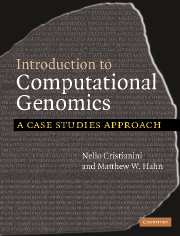Book contents
- Frontmatter
- Contents
- Preface
- Prologue: In praise of cells
- Chapter 1 The first look at a genome
- Chapter 2 All the sequence's men
- Chapter 3 All in the family
- Chapter 4 The boulevard of broken genes
- Chapter 5 Are Neanderthals among us?
- Chapter 6 Fighting HIV
- Chapter 7 SARS – a post-genomic epidemic
- Chapter 8 Welcome to the hotel Chlamydia
- Chapter 9 The genomics of wine-making
- Chapter 10 A bed-time story
- Bibliography
- Index
Chapter 8 - Welcome to the hotel Chlamydia
Whole genome comparisons
Published online by Cambridge University Press: 05 June 2012
- Frontmatter
- Contents
- Preface
- Prologue: In praise of cells
- Chapter 1 The first look at a genome
- Chapter 2 All the sequence's men
- Chapter 3 All in the family
- Chapter 4 The boulevard of broken genes
- Chapter 5 Are Neanderthals among us?
- Chapter 6 Fighting HIV
- Chapter 7 SARS – a post-genomic epidemic
- Chapter 8 Welcome to the hotel Chlamydia
- Chapter 9 The genomics of wine-making
- Chapter 10 A bed-time story
- Bibliography
- Index
Summary
Uninvited guests
Every human being has multiple species of bacteria living within them. Most of these bacteria, such as E. coli, are not harmful to us and are considered beneficial symbionts. The bacteria help us to digest certain foods or supply us with vitamins that we cannot make on our own, and we provide them with the nutrients and environment they need to survive. The benefits of having bacterial symbionts extend beyond the production of necessary chemicals. These bacteria actually prevent infection by other pathogenic bacteria simply by virtue of having already established their presence in our gut. In fact, after taking a course of antibiotics it is often recommended that people eat foods like yogurt to re-populate their stomach and intestines with symbiotic bacteria.
Genome rearrangements
Orthology and paralogy
Synteny blocks, inversions, and transpositions
Although there are many well-known examples of beneficial symbiotic relationships in nature, they tend to be interactions between free-living organisms such as bees and flowers or birds and rhinoceros (the appropriately named tick-bird eats ticks off the back of the rhino). As with our relationship with E. coli, however, there are many symbionts that are hidden from view because they live within their hosts. These symbionts often aid their hosts in digestion and benefit themselves by living in the stomach of a mobile organism. For instance, termites have specific protozoa (a type of single-celled eukaryote) living in their digestive tract to help with the digestion of wood.
- Type
- Chapter
- Information
- Introduction to Computational GenomicsA Case Studies Approach, pp. 128 - 140Publisher: Cambridge University PressPrint publication year: 2006



